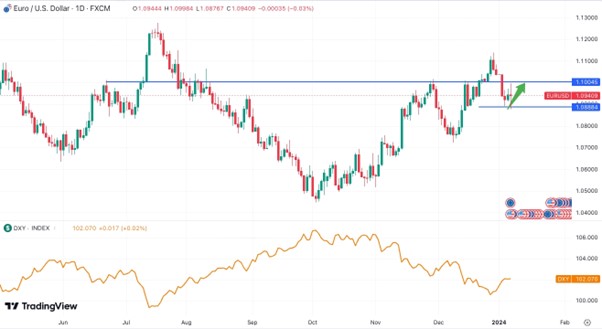The foreign exchange market has been marked by a series of nuanced movements, particularly in relation to the U.S. Dollar Index and major currency pairs such as EUR/USD and GBP/USD. Recent economic reports and data releases have contributed to these dynamics, influencing traders’ sentiments and market positions.
The U.S. Dollar Index has exhibited some volatility, primarily influenced by changes in inflation expectations and labor market data. A notable decline in consumer inflation expectations, as reported in recent surveys, has led to a slight retreat in the index. This shift underscores the market’s sensitivity to inflationary trends and their implications for future monetary policy.
In the Eurozone, the EUR/USD pair has found some support from positive economic indicators, such as an improvement in the Euro Area Economic Sentiment. This uplift in sentiment, however, is juxtaposed against ongoing concerns about the broader economic outlook, including the potential for interest rate adjustments by central banks in response to inflationary pressures and recessionary risks.
The GBP/USD pair, meanwhile, has capitalized on the general weakness of the American currency, climbing higher despite a lack of significant domestic catalysts. The pair’s movements reflect broader market dynamics, including shifts in risk appetite and speculation about monetary policy on both sides of the Atlantic.
The USD/CAD pair’s performance has been relatively muted, with the currency pair showing little reaction to fluctuations in oil prices, a key export for Canada. This stability suggests that other factors, such as interest rate differentials and broader market sentiment, are playing a more significant role in driving the pair’s movements.
The USD/JPY pair has been sensitive to changes in U.S. Treasury yields, reflecting the deep interconnection between interest rate trends and currency valuations. As yields move lower, the pair has faced downward pressure, highlighting the influence of monetary policy expectations and yield differentials on currency markets.
Looking ahead, the foreign exchange market is poised to continue responding to a complex interplay of economic data, central bank communications, and geopolitical developments. Key technical levels and indicators, such as moving averages and support/resistance zones, will serve as important markers for traders navigating these fluid conditions.
In summary, the current state of the foreign exchange market encapsulates the intricate balance between economic fundamentals, policy expectations, and market sentiment. As traders and investors digest incoming information, currency pairs will likely continue to exhibit volatility, underscoring the need for a nuanced and informed approach to navigating the forex landscape.

